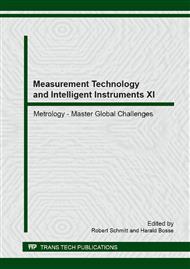p.64
p.70
p.81
p.87
p.94
p.101
p.111
p.118
p.125
Full Scale Calibration of a Combined Tactile Contour and Roughness Measurement Device
Abstract:
In current production metrology contour and roughness of work pieces has to be controlled in demanding small tolerances. It is important that the results not only have to be accurate, but also the measurement has to be performed effective and fast. It would be convenient to have the possibility measuring first a continuous surface profile and than performing different evaluations on adjacent segments. We describe a measurement system which is based on a tactile probe with a diamond tip. The position of each axis is measured by high resolution and high accuracy digital scales. The instrument is calibrated and traced back by only using one precision sphere covering approximately the whole measuring range of 24 mm. It is shown that with only that macroscopic calibration and adjustment the accuracy for roughness measurement in all arbitrary vertical positions is reached in the nm-range. The calibration and adjustment process is described and we show the verification of the accuracy by measuring several surface specimens. The results are compared to a Physikalisch-Technische Bundesanstalt (PTB) calibration certificates for those surface roughness standards.
Info:
Periodical:
Pages:
94-100
Citation:
Online since:
May 2014
Authors:
Keywords:
Price:
Сopyright:
© 2014 Trans Tech Publications Ltd. All Rights Reserved
Share:
Citation:


